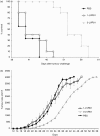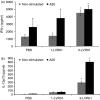Salmonella enterica serovar Typhimurium immunotherapy for B-cell lymphoma induces broad anti-tumour immunity with therapeutic effect
- PMID: 24834964
- PMCID: PMC4212956
- DOI: 10.1111/imm.12320
Salmonella enterica serovar Typhimurium immunotherapy for B-cell lymphoma induces broad anti-tumour immunity with therapeutic effect
Abstract
Despite the efficacy of current immune-chemotherapy for treatment of B-cell non-Hodgkin lymphoma, a substantial proportion of patients relapse, highlighting the need for new therapeutic modalities. The use of live microorganisms to develop anti-tumoural therapies has evolved since Coley's toxin and is now receiving renewed attention. Salmonella Typhimurium has been shown to be highly effective as an anti-tumour agent in many solid cancer models, but it has not been used in haemato-oncology. Here, we report that intra-tumoural administration of LVR01 (attenuated S. Typhimurium strain with safety profile) elicits local and systemic anti-tumour immunity, resulting in extended survival in a lymphoma model. LVR01 induces intra-tumoural recruitment of neutrophils and activated CD8(+) T cells, as well as increasing the natural killer cell activation status. Furthermore, a systemic specific anti-tumour response with a clear T helper type 1 profile was observed. This approach is an alternative therapeutic strategy for lymphoma patients that could be easily moved into clinical trials.
Keywords: bacteria; tumour immunology; vaccination.
© 2014 John Wiley & Sons Ltd.
Figures







Similar articles
-
Systemic and mucosal immunity induced by attenuated Salmonella enterica serovar Typhimurium expressing ORF7 of porcine reproductive and respiratory syndrome virus.Comp Immunol Microbiol Infect Dis. 2011 Jul;34(4):335-45. doi: 10.1016/j.cimid.2011.04.001. Epub 2011 May 2. Comp Immunol Microbiol Infect Dis. 2011. PMID: 21543119
-
SopB of Salmonella enterica serovar Typhimurium is a potential DNA vaccine candidate in conjugation with live attenuated bacteria.Vaccine. 2009 May 11;27(21):2804-11. doi: 10.1016/j.vaccine.2009.02.092. Epub 2009 Mar 11. Vaccine. 2009. PMID: 19428891
-
Control of B-cell lymphoma by therapeutic vaccination and acquisition of immune resistance is independent of direct tumour IFN-gamma signalling.Immunol Cell Biol. 2016 Jul;94(6):554-62. doi: 10.1038/icb.2016.9. Epub 2016 Jan 20. Immunol Cell Biol. 2016. PMID: 26786233
-
Combination of cytokine-induced killer and dendritic cells pulsed with antigenic α-1,3-galactosyl epitope-enhanced lymphoma cell membrane for effective B-cell lymphoma immunotherapy.Cytotherapy. 2016 Jan;18(1):91-8. doi: 10.1016/j.jcyt.2015.09.012. Cytotherapy. 2016. PMID: 26549382 Clinical Trial.
-
Optimizing Salmonella enterica serovar Typhimurium for bacteria-mediated tumor therapy.Gut Microbes. 2016;7(2):171-7. doi: 10.1080/19490976.2016.1155021. Gut Microbes. 2016. PMID: 26939530 Free PMC article. Review.
Cited by
-
Attenuated Salmonella enterica Serovar Typhimurium, Strain NC983, Is Immunogenic, and Protective against Virulent Typhimurium Challenges in Mice.Vaccines (Basel). 2020 Nov 3;8(4):646. doi: 10.3390/vaccines8040646. Vaccines (Basel). 2020. PMID: 33153043 Free PMC article.
-
Perspectives on Oncolytic Salmonella in Cancer Immunotherapy-A Promising Strategy.Front Immunol. 2021 Feb 25;12:615930. doi: 10.3389/fimmu.2021.615930. eCollection 2021. Front Immunol. 2021. PMID: 33717106 Free PMC article. Review.
-
Live Attenuated Salmonella enterica Expressing and Releasing Cell-Permeable Bax BH3 Peptide Through the MisL Autotransporter System Elicits Antitumor Activity in a Murine Xenograft Model of Human B Non-hodgkin's Lymphoma.Front Immunol. 2019 Nov 14;10:2562. doi: 10.3389/fimmu.2019.02562. eCollection 2019. Front Immunol. 2019. PMID: 31798573 Free PMC article.
-
Salmonella-Mediated Cancer Therapy: An Innovative Therapeutic Strategy.J Cancer. 2019 Aug 20;10(20):4765-4776. doi: 10.7150/jca.32650. eCollection 2019. J Cancer. 2019. PMID: 31598148 Free PMC article. Review.
-
Inflammasome activation, NLRP3 engagement and macrophage recruitment to tumor microenvironment are all required for Salmonella antitumor effect.Cancer Immunol Immunother. 2022 Sep;71(9):2141-2150. doi: 10.1007/s00262-022-03148-x. Epub 2022 Jan 21. Cancer Immunol Immunother. 2022. PMID: 35061085 Free PMC article.
References
-
- Briones J. Emerging therapies for B-cell non-Hodgkin lymphoma. Expert Rev Anticancer Ther. 2009;9:1305–16. - PubMed
-
- Coley WB. The treatment of malignant tumors by repeated inoculations of erysipelas. With a report of ten original cases. 1893. Clin Orthop Relat Res. 1991;(262):3–11. - PubMed
-
- Avogadri F, Martinoli C, Petrovska L, et al. Cancer immunotherapy based on killing of Salmonella-infected tumor cells. Cancer Res. 2005;65:3920–7. - PubMed
Publication types
MeSH terms
Substances
LinkOut - more resources
Full Text Sources
Other Literature Sources
Research Materials

